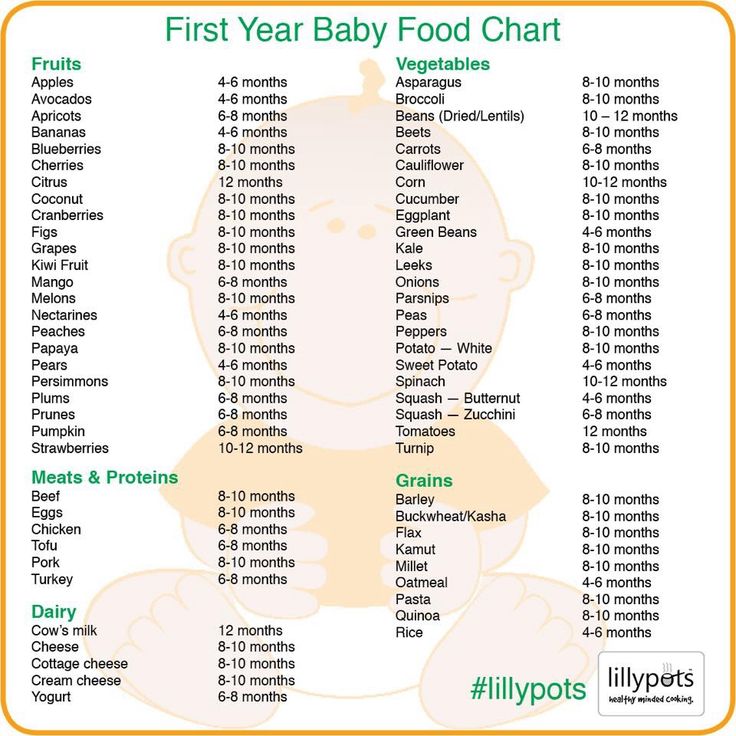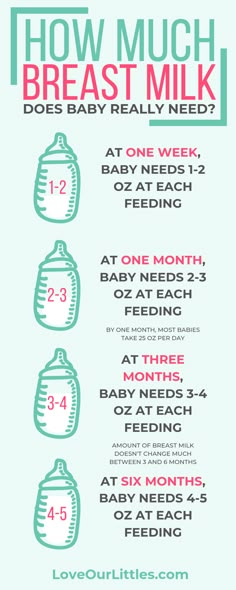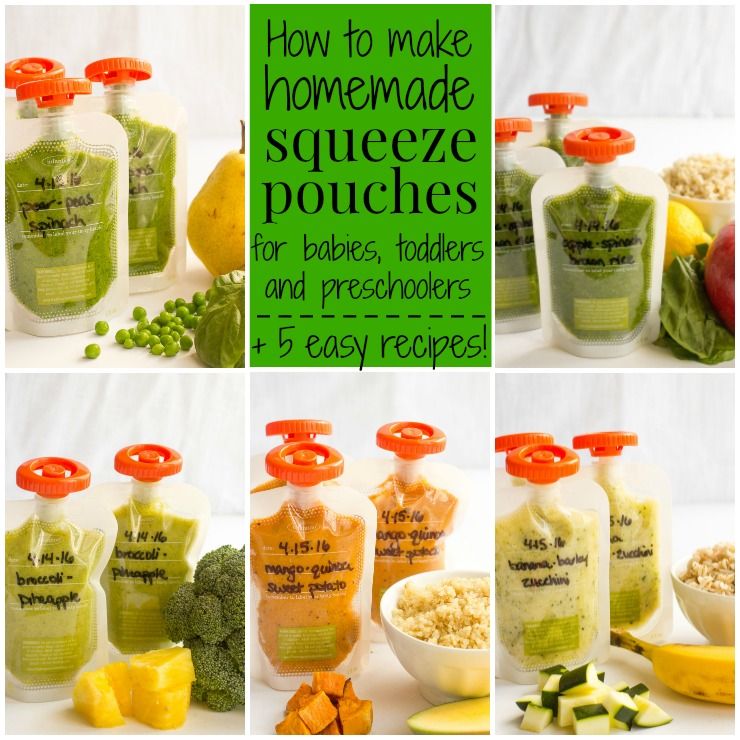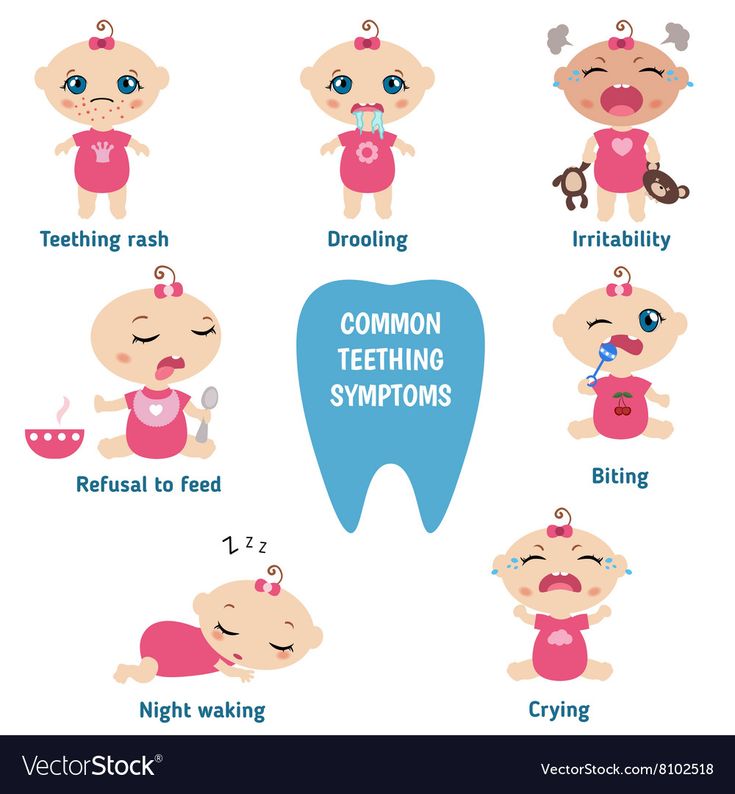List of baby foods by month
Foods to avoid feeding your baby
Foods to avoid giving your baby include honey, cow's milk, soy milk, fruit juice, sugar-sweetened beverages, unpasteurized foods, and foods with added sugars or too much sodium. Choking hazards are a serious concern, so don't offer large chunks, raw vegetables, nuts and seeds, hard or crunchy foods, sticky foods, or dollops of nut butters. If allergies run in your family or your baby has eczema, check with the doctor about introducing allergenic foods such as egfgs, peanuts, tree nuts, wheat, soy, fish, and shellfish.
As your baby grows, they'll be eager to sample food from your plate – and you'll be eager to introduce some variety. But not all foods are safe for your child.
Foods to avoid: Birth to 6 months
All food and beverages except breast milk or formula: The American Academy of Pediatrics (AAP) recommends feeding your baby only breast milk or formula for about the first 6 months.
Foods to avoid: 6 to 12 months
Honey: Honey can harbor spores of Clostridium botulinum, which causes botulism. An adult's intestinal tract can prevent the growth of these spores, but in a baby the spores can grow and produce life-threatening toxins.
Cow's milk and soy milk: Stick with breast milk or formula until your child's first birthday. Why? Your baby can't digest the proteins in cow's milk and soy milk during the first year, and these beverages contain minerals in amounts that can damage your baby's kidneys.
Fruit juice and sugar-sweetened beverages: Juice (even 100 percent fruit juice) and sugar-sweetened beverages such as soda and sports drinks aren't recommended for children under 12 months. When babies fill up on these drinks, they miss out on getting the nutrients they need. And though fruit juice seems healthy, it has far more calories and sugar than fresh fruit and can contribute to weight gain and tooth decay. The AAP recommends no fruit juice for babies, and just 4 ounces per day maximum for toddlers ages 1 to 3.
Unpasteurized foods: Don't give babies and children unpasteurized juice or cider or unpasteurized (raw) dairy products. These may contain harmful bacteria and parasites that can lead to serious illness or death.
These may contain harmful bacteria and parasites that can lead to serious illness or death.
Added sugars: Avoid added sugar in the diets of children under age 2, the U.S. Department of Agriculture and U.S. Department of Health and Human Services advise. These are sugars and syrups that are added to foods or beverages when they are processed or prepared. This doesn't include sugars found in milk and fruits. Too much added sugar in children's diets has been linked to obesity and increased risk for future health problems such as diabetes and heart disease. Check the Nutrition Facts label on packaged foods, and avoid those that list 1 g or more of "Added Sugars."
Too much sodium: Sodium is an essential nutrient primarily consumed as salt. However, too much can be harmful. Children this age don't need more than 1,200 mg of sodium per day, according to the USDA and DHHS. Check the Nutrition Facts label when buying canned, frozen, and packaged foods.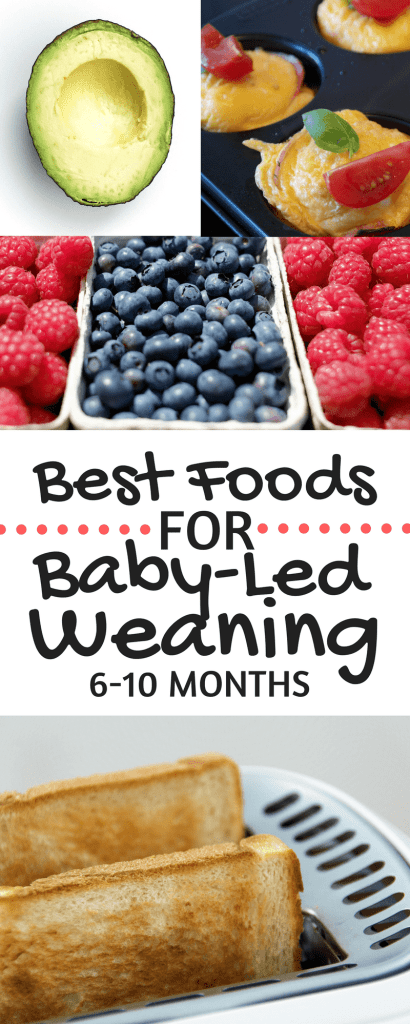
Large chunks: A chunk of food can get stuck in your baby's throat. The AAP recommends that you cut food into pieces no larger than 1/2 inch. For example, cut up fruits such as grapes, cherry tomatoes, and strawberries, and shred or finely chop meats, vegetables, and cheeses.
Advertisement | page continues below
Raw vegetables: Soft-cook vegetables such as carrots, celery, and broccoli, and dice, shred, or cut them into pieces no larger than 1/2 inch before serving.
Nuts and seeds: Remove seeds and pits from fresh fruit such as watermelon, peaches, plums, and cherries before serving. And don't feed your baby nuts or seeds, such as sunflower or pumpkin seeds. Seeds may be too small to choke on but can get stuck in a child's airway and cause an infection.
Hard or crunchy foods: Nuts, popcorn, and pretzels are all choking hazards, as are all hard candies and cough drops.
Sticky foods: Chewing gum and sticky foods – such as jelly or gummy candies, dried fruit, and marshmallows – can get lodged in your baby's throat.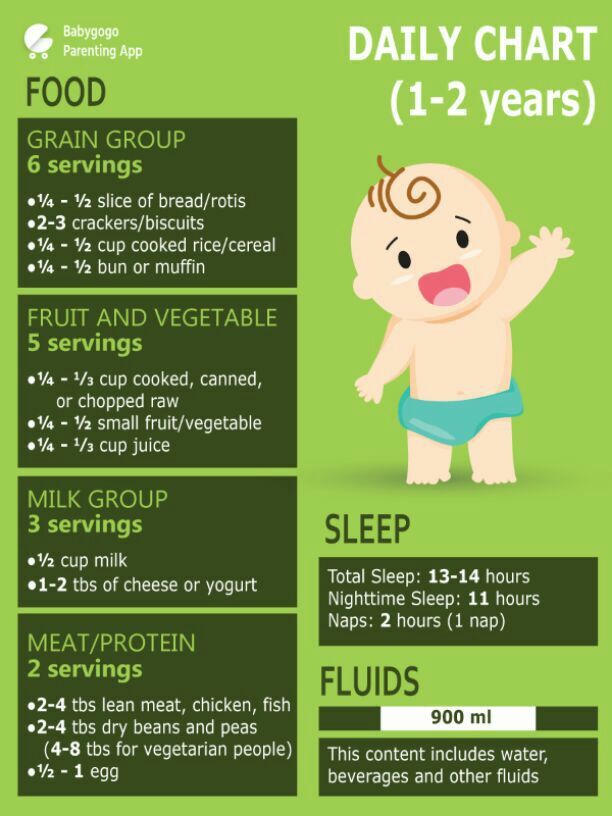 Stringy, melted cheese can also be a choking hazard.
Stringy, melted cheese can also be a choking hazard.
Nut butter: The sticky consistency of peanut butter and other nut butters can make it hard for your baby to swallow it. Spread nut butter thinly on bread or crackers. Or thin it with water or applesauce.
Learn more about preventing choking in young children.
Find out about choosing safe finger foods and which foods can be unsafe for toddlers and children up to age 5.
The latest on children and food allergies
Doctors used to recommend waiting until age 1 or even later to introduce solid foods that are common allergens, especially with children at risk for allergies. But the AAP has changed its tune, because studies show that these delays don't help prevent allergies and may even increase the risk of them.
You may be told to introduce foods one at a time, waiting three to five days after each new food to watch for any allergic reaction. Or your doctor may say it's fine to start multiple new foods at once.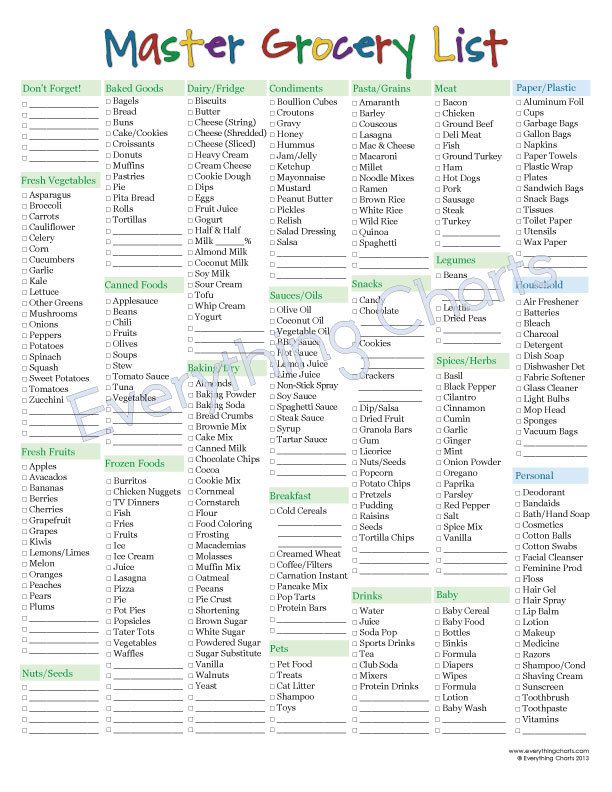 If you believe your baby is likely to have food allergies – for example, if allergies run in your family or your baby has eczema – check with their doctor to determine the best strategy for introducing allergenic foods, which include eggs, milk, peanuts, wheat, soy, tree nuts, fish, and shellfish.
If you believe your baby is likely to have food allergies – for example, if allergies run in your family or your baby has eczema – check with their doctor to determine the best strategy for introducing allergenic foods, which include eggs, milk, peanuts, wheat, soy, tree nuts, fish, and shellfish.
Read more about food allergies in children.
How much should my baby eat? A guide to baby food portions
- Community
- Getting Pregnant
- Pregnancy
- Baby names
- Baby
- Toddler
- Child
- Health
- Family
- Courses
- Registry Builder
- Baby Products
Advertisement
Wondering how much to feed your baby? This can be hard to figure out, especially when you're starting solids and most of your baby's food ends up on your little one or the floor. It's also difficult to determine how much an 8-month-old (or older baby) should eat – babies this age are more interested in solid foods but still get most of their nutrition from breast milk or formula.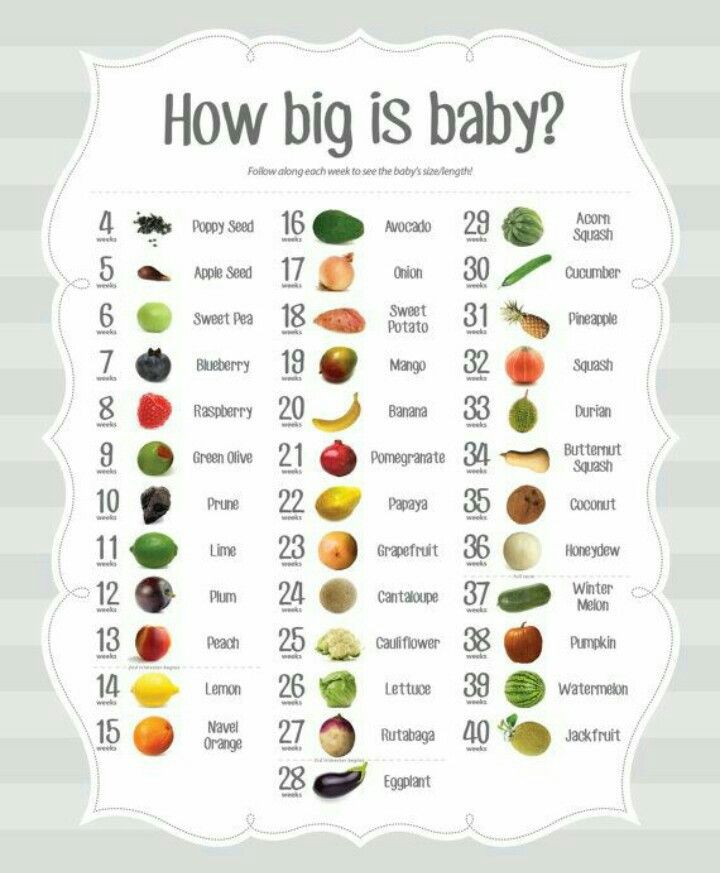 This visual guide to baby food portions can help you figure out how much your baby should eat at every stage.
This visual guide to baby food portions can help you figure out how much your baby should eat at every stage.
Photo credit: Karla Martin for BabyCenter
How much should my baby eat?
Do you worry that your baby is eating too little or too much? Your baby will self-regulate her food intake based on what their body needs, so let their appetite be your guide.
It's helpful to have a reference point, however. Here are photos of how much solid food a baby typically eats in a day. You can also ask your baby's doctor for feeding advice.
This visual guide shows:
- Portions for infants who are new to solids (typically 4 to 6 months)
- Two sample meals for a younger baby (6 to 8 months)
- Three sample meals and two snacks for an older baby (8 to 12 months) from a menu developed by the American Academy of Pediatrics (AAP)
Your little one may eat less or more than what's shown here. Your job is to provide a variety of healthy foods at regular intervals without pressure, and their job is to decide what and how much to eat.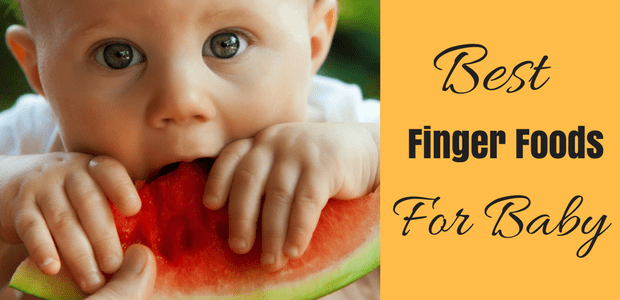
Photo credit: iStock.com / UntitledImages
Watch for signs your baby is full
Lots of factors – including activity level, growth spurts or plateaus, illness, and teething – will affect your baby's appetite, which can vary daily.
End feeding when they signal that they're done. Signs of being full include:
- Turning their head away
- Refusing to open their mouth for another bite after they've swallowed (resist the urge to encourage your baby to have one last spoonful)
- Leaning back in their chair
- Playing with the spoon or food rather than eating
Photo credit: Karla Martin for BabyCenter
How much a 4- to 6-month-old should eat
When your baby is developmentally ready for solids, typically around 4 to 6 months, talk to their doctor about introducing solid foods. The first bites are mostly about them getting used to the idea of having something different in their mouth.
- Start with a very small amount, 1 to 2 teaspoons, of a single-ingredient puree.

- Gradually increase to 1 to 2 tablespoons of food once a day.
- Follow your baby's fullness cues.
Popular first foods include pureed mango, banana, chicken, turkey, beef, peas, sweet potatoes, and infant cereal. It's up to you what food to start with, but wait 3 to 5 days between introducing each new food to make sure your baby doesn't have an allergic reaction or food intolerance. (And remember, no cow's milk or honey until age 1.)
Photo credit: Karla Martin for BabyCenter
How much a 6- to 8-month-old should eat
As your little one gets more comfortable with solids, you can increase the frequency of meals and variety of food.
- Transition from one to two meals a day, typically by 8 months.
- Over time, add a second food to each meal. The photo above is an example of a meal with two foods.
- Once you've worked up to two meals with two foods each, aim for a balance of proteins, vegetables, fruits, and grains in their daily diet.
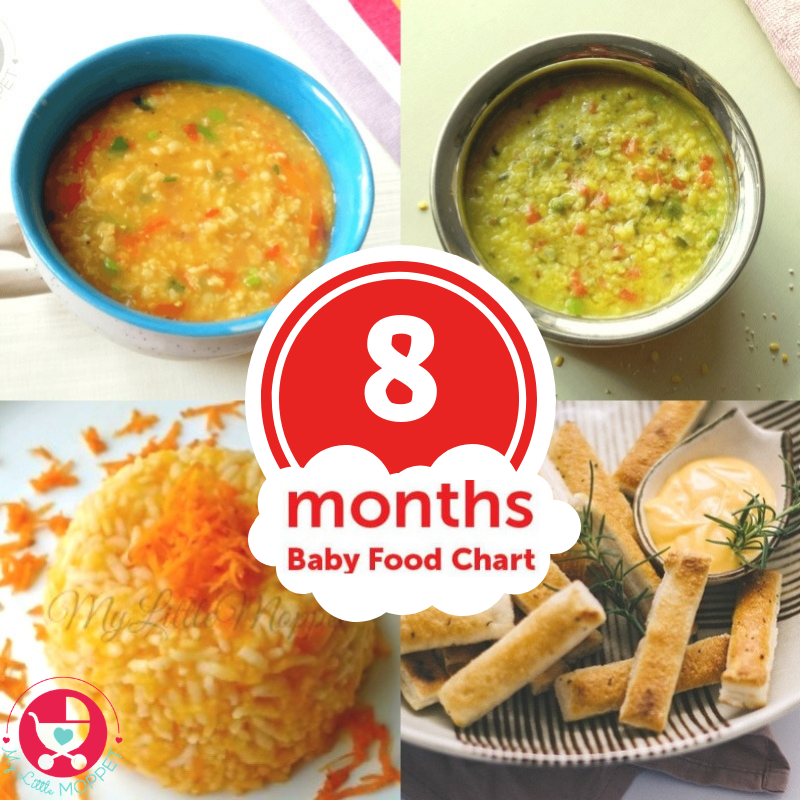
- Whenever you introduce a new food, start with a very small amount, a teaspoon or two, to allow your baby to get used to its flavor and texture.
- Start with a soupy consistency. Gradually add more texture as their eating skills improve.
Expect their intake of breast milk or formula to go down. They'll start drinking less of it as they eat more solid foods. Provide healthy options at mealtimes, and let them choose how much to eat.
Note: The jars in all photos are standard 4-ounce baby food jars.
Photo credit: Karla Martin for BabyCenter
Breakfast for a younger baby (6 to 8 months)
Cereal and fruit make an easy combination for a morning meal.
Grain: Iron-fortified, whole-grain infant cereal is a popular first grain. At 6 months, a typical daily portion of infant cereal mixed with breast milk or formula might be 2 to 3 tablespoons, increasing to 4 to 8 tablespoons (1/4 to 1/2 cup) by 8 months. (It's best to avoid rice cereal, though.)
(It's best to avoid rice cereal, though.)
Fruit: Babies love the natural sweetness of fruits like pears, apples, berries, prunes, and stone fruits. Between 6 and 8 months, a baby will typically transition from about 2 to 3 tablespoons of fruit puree a day to 4 to 8 tablespoons (1/4 to 1/2 cup) of mashed or minced fruit.
Photo credit: Karla Martin for BabyCenter
Dinner for a younger baby (6 to 8 months)
If you serve a grain and fruit in the morning, consider offering a protein-rich food and vegetable later in the day. Your child may eat more or less than the amounts shown.
Protein: A baby might transition from eating 1 to 2 tablespoons of meat puree at 6 months to 2 to 4 tablespoons at 8 months, for example. Other good protein sources include cheese, unsweetened plain whole-milk yogurt, tofu, beans, and lentils.
Vegetables: Between 6 and 8 months, a baby will typically transition from about 2 to 3 tablespoons of vegetable puree a day to 4 to 8 tablespoons (1/4 to 1/2 cup). Try classic favorites like carrots, spinach, or butternut squash, as well as less traditional first foods such as parsnips, beets, or asparagus.
Try classic favorites like carrots, spinach, or butternut squash, as well as less traditional first foods such as parsnips, beets, or asparagus.
As your child's eating skills improve, gradually add more texture by dicing or mincing foods.
Photo credit: Karla Martin for BabyCenter
How much an 8- to 12-month-old should eat
By 8 months or so, your baby is likely getting the hang of eating and needs to eat more calories to support their growing body. But since their little belly can't hold a lot of food, they'll need to eat more often. Every baby is different, but this may be a good time to try offering a third solid food meal.
During this period:
- Continue to give your baby breast milk or formula.
- Add morning and afternoon snacks. (Some babies this age are happy with breast milk or formula as their snack, while others gravitate toward solid foods.) Once you've added a third meal and snacks, your baby will be eating or drinking something about every two to three hours.
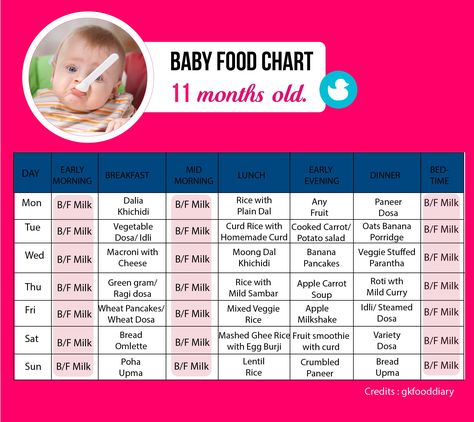
- Continue to aim for a mix of proteins, vegetables, fruits, and grains.
- Introduce coarser and chunkier textures, for example, by dicing or mincing food instead of pureeing it, and graduate to soft finger foods as your baby's eating skills improve.
- Avoid foods with added sugars. Check the Nutrition Facts label on packaged foods, and try to steer clear of foods that list 1 gram or more of "Added Sugars."
- Provide healthy options, and let your baby choose how much to eat.
To visualize daily portions for an 8- to 12-month-old, check out the following photos of a typical day's menu for a baby this age, developed by the AAP.
Your child may eat more or less than these amounts. If you're concerned about how much your baby is eating, talk to their doctor for advice.
Photo credit: Karla Martin for BabyCenter
Breakfast for an older baby (8 to 12 months)
The AAP sample menu for a baby 8 to 12 months features a breakfast consisting of:
- 4 to 8 tablespoons (1/4 to 1/2 cup) whole-grain infant cereal mixed with formula or breast milk
- 4 to 8 tablespoons (1/4 to 1/2 cup) diced fruit
Note: This is an example.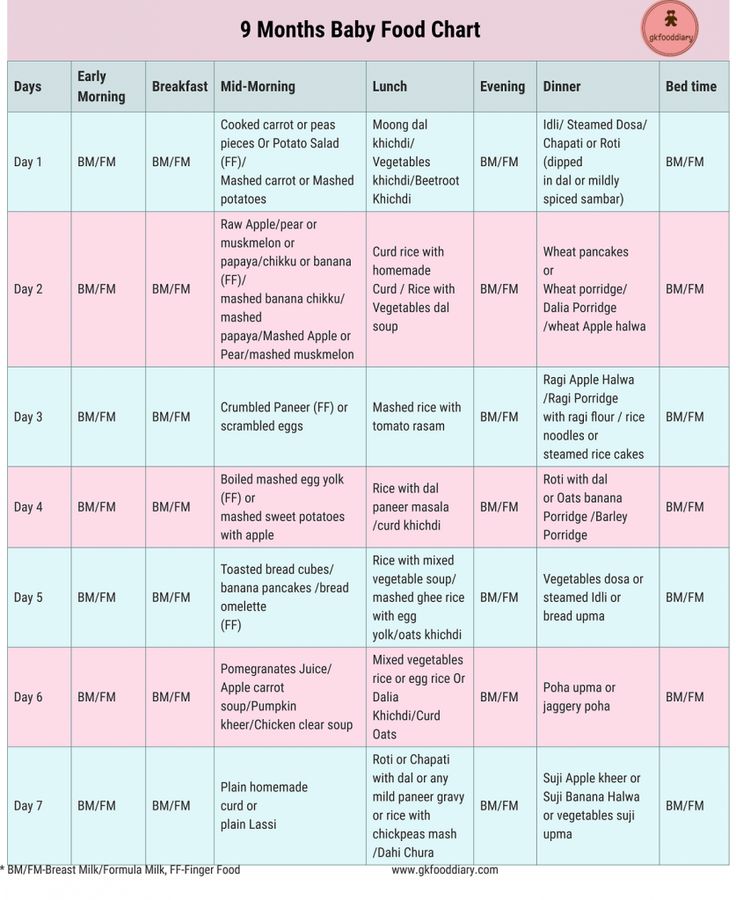 Your baby may eat different foods and amounts.
Your baby may eat different foods and amounts.
Photo credit: Karla Martin for BabyCenter
Morning snack for an older baby (8 to 12 months)
The AAP sample menu for a baby 8 to 12 months features a morning snack consisting of:
- 4 tablespoons (1/4 cup) diced cheese or cooked vegetables
Note: This is an example of a morning snack, which babies typically add sometime between 8 and 12 months. Your baby may eat different foods and amounts.
Photo credit: Karla Martin for BabyCenter
Lunch for an older baby (8 to 12 months)
The AAP sample menu for a baby 8 to 12 months features a lunch consisting of:
- 4 to 8 tablespoons (1/4 to 1/2 cup) unsweetened plain whole-milk yogurt or cottage cheese, or minced meat
- 4 to 8 tablespoons (1/4 to 1/2 cup) diced or mashed yellow or orange vegetable
Note: This is an example. Your baby may eat different foods and amounts.
Photo credit: Karla Martin for BabyCenter
Afternoon snack for an older baby (8 to 12 months)
The AAP sample menu for a baby 8 to 12 months features an afternoon snack consisting of:
- 4 tablespoons (1/4 cup) diced fruit or unsweetened plain whole-milk yogurt
- 1 whole-grain teething biscuit or cracker
Note: This is an example of an afternoon snack, which babies typically add sometime between 8 and 12 months. Your baby may eat different foods and amounts.
Your baby may eat different foods and amounts.
Photo credit: Karla Martin for BabyCenter
Dinner for older baby (8 to 12 months)
The AAP sample menu for a baby 8 to 12 months features a dinner consisting of:
- 4 tablespoons (1/4 cup) minced or ground poultry or meat, or diced tofu
- 4 to 8 tablespoons (1/4 to 1/2) cup diced, cooked green vegetable
- 4 tablespoons (1/4 cup) noodles, pasta, rice, or potato
- 4 tablespoons (1/4 cup) diced fruit
Note: This is an example. Your baby may eat different foods and amounts.
Photo credit: Karla Martin for BabyCenter
How much should my baby drink once they start eating solids?
Breast milk or formula will fully meet your child's hydration needs until they're about 6 months old. They may start drinking less as solid foods become a bigger part of their diet. Here are typical daily amounts by age – your baby's intake may be different, however.
6 to 8 months: 24 to 32 ounces of formula, or continued breastfeeding on demand
8 to 12 months: 24 ounces of formula, or continued breastfeeding on demand
Water: You can offer your baby water once they start eating solids, but let them self-regulate how much they drink. The Centers for Disease Control and Prevention (CDC) recommends giving babies who are 6 to 12 months old 4 to 6 ounces of water a day, but what your baby decides to drink may vary. They may drink more on a hot day, for example.
Avoid juice: Juice isn't recommended for babies younger than 12 months.
Photo credit: iStock.com / SDI Productions
Your baby has the final say
Keep in mind that these portions are an estimate. The truth is, every baby is different, and there's no set amount of food that's appropriate for every baby at every stage.
If you're worried about whether your baby is eating enough – or too much – the best advice is to look for and respond to signs that your baby is full.
Your baby's doctor will chart their weight gain at regular intervals. If the doctor sees a consistent growth curve and doesn't have other concerns, your baby is most likely eating the right amount of food.
Hungry for more?
Age-by-age guide to feeding your baby
The 10 best foods for babies
The worst foods for babies
Using spices and seasoning in baby food
Elizabeth Dougherty
Elizabeth Dougherty is a veteran parenting writer and editor who's been contributing to BabyCenter since 2015. She's an intrepid traveler, devoted yogi, and longtime resident of Silicon Valley, where she lives with her husband and son.
Advertisement | page continues below
Union of Pediatricians of Russia
Introduction of complementary foods
How to properly introduce complementary foods is one of the most pressing issues that concern parents.
In the first months of life, the main food for the baby is breast milk or an adapted milk formula, however, as the child grows and develops, this becomes insufficient for him and it is necessary to think about the introduction of complementary foods.
Your baby is over 4 months old. He has noticeably grown up, become more active, is interested in objects that fall into his field of vision, carefully examines them and reaches for them. The child's emotional reactions have become much richer: he smiles happily at all people, makes various sounds. Perhaps you notice that the child looks into your plate with interest, closely monitors what and how you eat, does this mean that it is time to introduce complementary foods? And where is the best place to start? Let's figure it out!
When should complementary foods be started?
According to the Program for optimizing the feeding of infants in the first year of life in the Russian Federation (2019), the recommended age for the introduction of complementary foods is in the range from 4 to 6 months.
The following points will help determine the readiness of the baby for the introduction of complementary foods:
1. Food interest - you can check its presence as follows: during your meal, give the baby an empty spoon or fork, and if he plays with it, licks it, then there is no food interest yet; but if the child is dissatisfied with the fact that the spoon is empty, food interest has probably appeared. “But how does a child understand that there should be food in a spoon?” Parents often ask. The answer is quite simple: take your baby to the table with you so that he can see how you eat!
“But how does a child understand that there should be food in a spoon?” Parents often ask. The answer is quite simple: take your baby to the table with you so that he can see how you eat!
2. The child can sit alone or with support. It is unacceptable to feed the child lying down, because he may choke.
3. Extinction of the “pushing out” reflex - when the baby pushes out of the mouth both the offered food and the pacifier, etc.
Why is it not recommended to introduce complementary foods before 4 and after 6 months of life?
Before 4 months of life, the baby is not yet ready to digest food other than breast milk or infant formula. By this age, a number of digestive enzymes mature, a sufficient level of local immunity is formed, which reduces the risk of developing allergic reactions, the child acquires the ability to swallow semi-liquid and thicker food, which is due to the extinction of the “spoon ejection reflex”. The introduction of complementary foods after 6 months can cause a pronounced deficiency of micronutrients (iron, zinc, etc. ) and lead to a delay in the formation of chewing skills for thick foods. Too late the introduction of a variety of products increases the risk of allergic reactions. Remember that the timing of the introduction of complementary foods is set individually, taking into account the readiness of the child to accept new foods.
) and lead to a delay in the formation of chewing skills for thick foods. Too late the introduction of a variety of products increases the risk of allergic reactions. Remember that the timing of the introduction of complementary foods is set individually, taking into account the readiness of the child to accept new foods.
Complementary feeding guidelines:
1. introduce a new product in the first half of the day to track possible reactions to it;
2. cereals, vegetable / fruit / meat purees should be introduced, starting with monocomponent ones, gradually adding other products of this group;
3. start giving a new product with 1/2 teaspoon, gradually increasing the volume to the age norm within a week;
4. New products are not recommended to be introduced during acute infectious diseases or at some special moments (moving to another apartment, leaving the city, on vacation, illness of parents, etc.).
What is the best way to start complementary foods?
The first complementary food can be anything.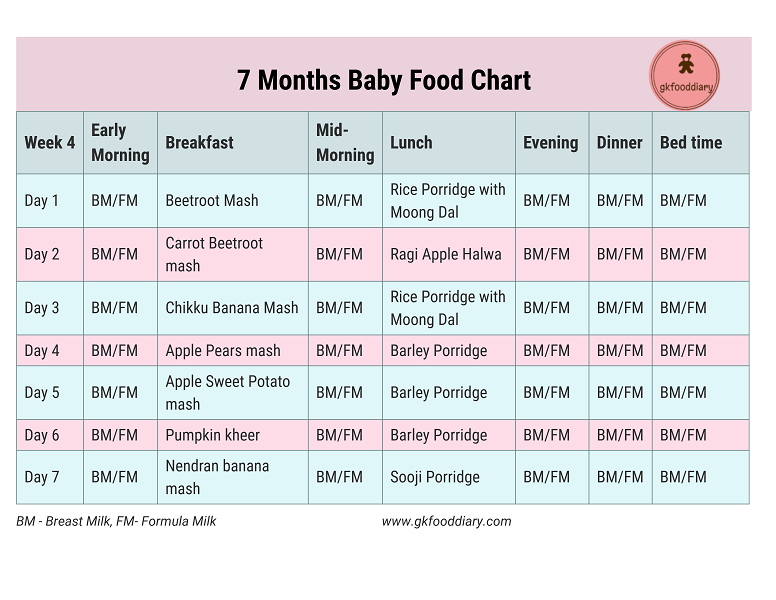 Often parents worry that if the child first tries the fruit, then because of its sweet taste, he will refuse other foods. We hasten to reassure you: breast milk is also sweet, so babies may like sweet fruits / berries more, but this does not mean at all that he will refuse vegetables or cereal. Traditionally, they begin to introduce complementary foods in the form of mashed potatoes, but if the child shows interest in “pieces”, then, observing the safety rules, you can give them. Also, along with the introduction of complementary foods, you can offer the child water.
Often parents worry that if the child first tries the fruit, then because of its sweet taste, he will refuse other foods. We hasten to reassure you: breast milk is also sweet, so babies may like sweet fruits / berries more, but this does not mean at all that he will refuse vegetables or cereal. Traditionally, they begin to introduce complementary foods in the form of mashed potatoes, but if the child shows interest in “pieces”, then, observing the safety rules, you can give them. Also, along with the introduction of complementary foods, you can offer the child water.
With the start of the introduction of complementary foods, the child is gradually transferred to a 5-time feeding regimen. If the baby shows that he is full and does not want to eat anymore (for example, leaning back or turning away from food), then you should not continue to force feed him, because this can lead to eating disorders in the future. Also, do not force the child to eat as much as possible before bedtime in the hope that he will not wake up for nightly feedings.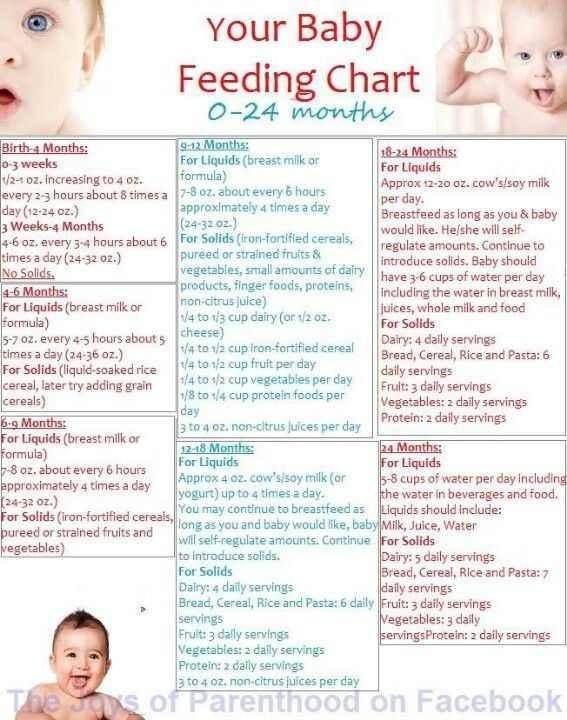
Traditionally, in our country, complementary foods begin with vegetables or cereals.
Vegetables: zucchini, broccoli, cauliflower, pumpkin, etc. If the child did not like the dish, for example, broccoli, do not give up on your plan and continue to offer this vegetable in small quantities daily, you can even not once, but 2-3 times, and after a while (7-14 days) the baby will get used to the new taste. This diversifies his diet, will help form the right taste habits in the child.
As for cereals, it is worth starting with dairy-free gluten-free ones - buckwheat, corn, rice. You can use commercial baby food porridge, which is enriched primarily with iron. In addition, such porridge is already ready to eat, you just need to dilute it with water, which will save you a lot of time.
It is also recommended to add oil to food, for example, vegetable puree to vegetable puree, and butter to porridge.
Of meat products, lean meats, such as mashed turkey or rabbit, are most preferred to start complementary foods.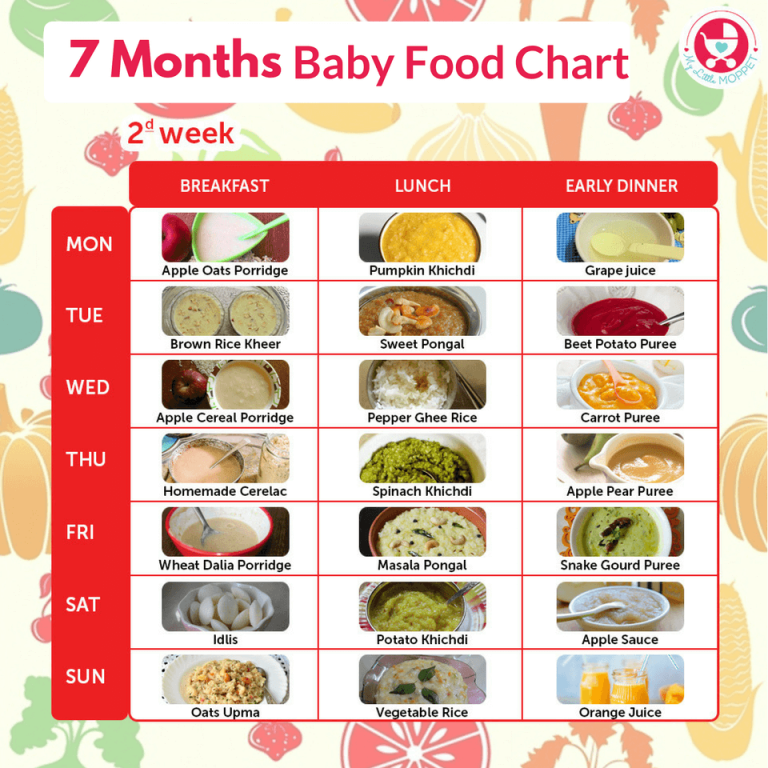 Meat puree contains iron, which is easily absorbed, and adding meat to vegetables improves the absorption of this micronutrient from them. Subsequently, the daily use of children's enriched porridge and mashed meat allows you to meet the needs of babies for iron, zinc and other micronutrients.
Meat puree contains iron, which is easily absorbed, and adding meat to vegetables improves the absorption of this micronutrient from them. Subsequently, the daily use of children's enriched porridge and mashed meat allows you to meet the needs of babies for iron, zinc and other micronutrients.
When introducing fruit purees (apple, pear, peach, prunes, etc.) into your baby's diet, you should pay special attention to the composition of the product - it is important that it does not contain added sugar.
Fish is a source of easily digestible protein and contains a large amount of polyunsaturated fatty acids, including the omega-3 class, as well as vitamins B2, B12, and minerals. Preference should be given to oceanic fish, preferably white (cod, hake, pollock, sea bass, etc.), salmon can be recommended from red, and pike perch from river.
Fermented milk products are prepared using a special starter culture that breaks down milk protein, so that the baby can get an indispensable set of amino acids in a well-available form. Some foods have added prebiotics, certain vitamins and minerals. Their regular use favorably affects the functioning of the intestines, increases appetite and the absorption of micronutrients.
Some foods have added prebiotics, certain vitamins and minerals. Their regular use favorably affects the functioning of the intestines, increases appetite and the absorption of micronutrients.
Recommendations and timing of the introduction of complementary foods for children at risk of developing food allergies and suffering from food allergies are the same as for healthy children. Delayed introduction of highly allergenic foods has previously been recommended to prevent the development of allergic diseases in children at risk. There is now evidence that this practice may lead to an increase rather than a decrease in the incidence of food allergies. The most common highly allergenic foods include cow's milk, chicken eggs, soybeans, wheat, peanuts, tree nuts, shellfish and fish. If a child has a high risk of developing allergies or an existing allergic disease, it is recommended to consult a pediatrician, an allergist-immunologist before introducing highly allergenic products.
By the age of 8 months, when all the main food groups have already been introduced and your baby is improving his skills to eat on his own, special attention should be paid to the diversity of the composition of dishes and the change in food consistency - from puree to finely and coarsely ground. Soft foods cut into small pieces (fruits, vegetables, meat, etc.) are perfect for a little gourmet, which diversifies his diet and will contribute to the formation of chewing skills.
By 9–12 months, most babies have the dexterity to drink from a cup (holding with both hands) and to eat foods prepared for other family members. This behavior needs to be encouraged, but combined with regular feeding to meet energy and nutrient requirements.
It is advisable to use industrial products that are designed specifically for young children after a year.
What should not be given to the baby?
It is not recommended to add salt or sugar to food to enhance the taste.
Drinks that should be avoided include fruit juices, whole cow and goat milk (whole milk is not recommended for children under one year old, and even longer, due to a high risk of developing iron deficiency and increased stress on the kidneys), sweet fruit drinks, compotes and carbonated drinks.
Also, some foods should be excluded from the diet of infants: solid round foods (for example, nuts, grapes, raw carrots, raisins, peas, etc.), due to the fact that the child can choke on them.
It is not recommended to eat products with added sugar, for example, confectionery (marshmallow, marshmallow, marmalade, jam, jam, cookies, waffles, etc.), etc.
You should not give your child the meat of large predatory fish (shark, bigeye tuna, king mackerel, swordfish): these types of fish accumulate more harmful substances than others.
It is forbidden to give honey to children under one year old due to the fact that it may contain spores of Clostridium botulinum bacteria, which in the still immature digestive system of babies are able to multiply, produce toxins directly inside the intestines and, thus, cause infant botulism, which can be fatal. outcome.
outcome.
Do not give babies raw meat, fish, eggs, caviar, salted fish, soft pickled cheeses because of the risk of intestinal infections.
If you follow all these simple rules, your baby will grow up healthy and happy!
Diets for different ages
References:
1. Methodological recommendations. The program for optimizing the feeding of children in the first year of life in the Russian Federation. [Internet]. - M.: Union of Pediatricians of Russia, 2019. [Methodicheskie rekomendaczii. Programma optimizaczii vskarmlivaniya detej pervogo goda zhizni v Rossijskoj Federaczii. [Internet]. – Moscow: Soyuz pediatrov Rossii, 2019.(In Russ.).] Available: http://www.pediatr-russia.ru/information/dokumenty/other-docs/nacprog1year_2019.pdf Link active as of 20.04.2020
2. Duryea T.K. Introducing solid foods and vitamin and mineral supplementation during infancy. In: Post T, ed. UpToDate . Waltham, Mass.: UpToDate; 2020. www.uptodate.com. Accessed April 20, 2020.
www.uptodate.com. Accessed April 20, 2020.
3.Fleischer D.M. Introducing highly allergenic foods to infants and children. In: Post T, ed. UpToDate . Waltham, Mass.: UpToDate; 2020. www.uptodate.com. Accessed April 20, 2020.
scheme for the first complementary feeding of a child (table) with artificial and breastfeeding, what can be given to a baby
The need to introduce complementary foods in modern mothers has long been beyond doubt. Pediatricians, pediatric nutritionists and other graduates unanimously say that at some point both mother's milk and formula are not enough to satisfy the growing needs of the child's body for useful trace elements and vitamins. That's when it's time to introduce complementary foods. The fact that your baby is ready to get new experiences and try tastes so far unknown to him is indicated by the presence of the following signs:
• doubling the initial weight of the child,
• ability to sit with support,
• child does not push food out of his mouth,
• curiosity and desire to try something from the common table.
Signs of malnutrition in a child, constant feeling of hunger and anxiety associated with it, and weight loss can also be important signals for the start of complementary foods. In these cases, it is recommended to immediately contact a specialist and share your observations with him.
Contents:
What foods should I start complementary foods with
Fruits, vegetables or cereals? Which of these foods are best for starting complementary foods? Experts have long answered this question as follows: if the baby is underweight, suffers from frequent loose stools, it is advisable to start with cereals (of course, gluten-free and dairy-free), and if everything is fine with weight, then vegetables will be the first in line. Also, vegetable complementary foods are recommended for breastfed children with constipation problems, rickets, or those born prematurely, whose weight is normal or exceeds the standards.
Why not fruits? Everything is simple. Fruits have a bright and sweet taste, and after trying an apple or banana first, the baby is likely to refuse zucchini or broccoli, which do not have the same rich taste. Therefore, the introduction of fruit purees and juices into the diet is postponed until vegetable purees become a familiar dish on the menu. As for cereals, buckwheat, rice and corn are first introduced, as they are characterized by the absence of gluten, saturate and are well digested.
Fruits have a bright and sweet taste, and after trying an apple or banana first, the baby is likely to refuse zucchini or broccoli, which do not have the same rich taste. Therefore, the introduction of fruit purees and juices into the diet is postponed until vegetable purees become a familiar dish on the menu. As for cereals, buckwheat, rice and corn are first introduced, as they are characterized by the absence of gluten, saturate and are well digested.
Read also: How to properly teach a child to different tastes
Avoiding mistakes
In order for the introduction of complementary foods not to become a test for either the baby or the mother, you need to follow some recommendations. Most importantly, be patient and don't get too upset if things don't go according to plan. Each child is individual, as are their taste preferences and needs.
• Start complementary foods if the baby is perfectly healthy. Contraindications for the introduction of new products will be teething, colds, stress associated with separation or moving, recent or planned vaccinations.
• New foods are introduced gradually, starting with half a teaspoon. In the absence of allergies or digestive problems, the amount of the product is approximately doubled the next day. Sometimes the introduction of a new product stretches up to a week. Do not rush, give the child the opportunity to "taste" this dish. If the baby flatly refuses the offer, postpone the acquaintance for at least a week.
• Do not force your child to eat. After all, your goal is to introduce your child to new tastes and help develop good eating habits.
• The best time for the first feeding is after the morning feed until 12 noon, when the baby is already hungry and ready to eat something else. In case something goes wrong, you will know about it during the day, not at night.
• If you experience an adverse reaction to the product, such as an allergy, seek medical advice immediately. Then, in agreement with the doctor, offer this dish after a certain period of time.
• Gradually increase the amount recommended by your pediatrician.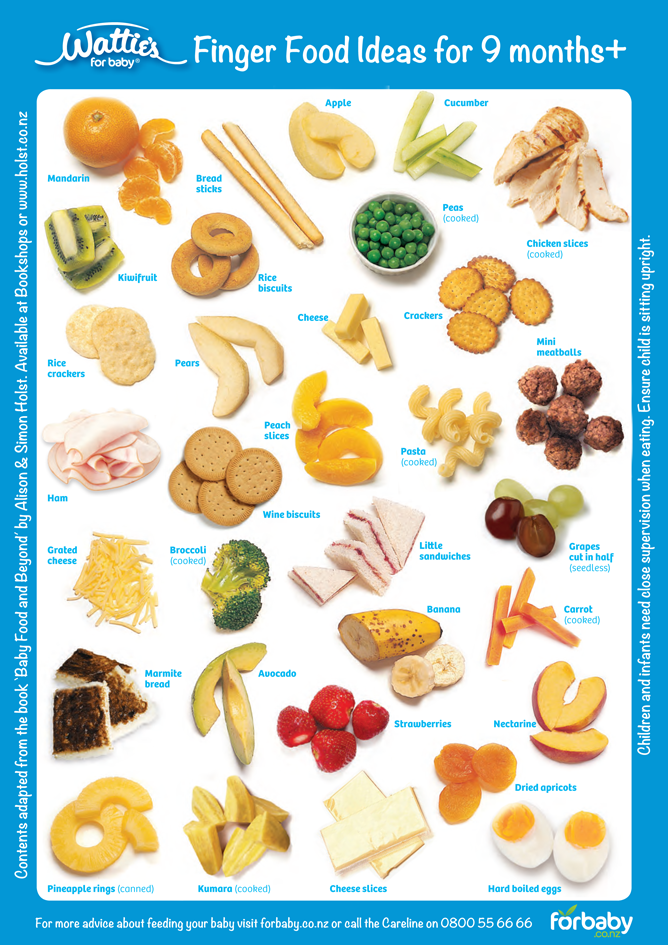 If you don't fit within a week, don't worry. Listen to your child and act accordingly.
If you don't fit within a week, don't worry. Listen to your child and act accordingly.
• Always start feeding with complementary foods. Only then offer breast milk or formula.
• Stick to a 5-meal schedule. Feed your baby at the same time every day.
• Food offered to the baby must be thermally processed - boiled or steamed. The dish should be at a comfortable temperature - about 37 ° C.
• Purees and cereals should be of a liquid consistency so that a child who does not yet know how to chew can comfortably eat them. Thicker dishes with lumps and pieces are introduced into the diet by about a year, when there are already several teeth.
• Do not use salt, sugar or spices when preparing complementary foods. Also, do not add them in order to force the child to eat something. Let the baby get used to natural tastes.
• Complementary foods are prepared at one time and should never be refrigerated until the next meal. Everything should be only the first freshness.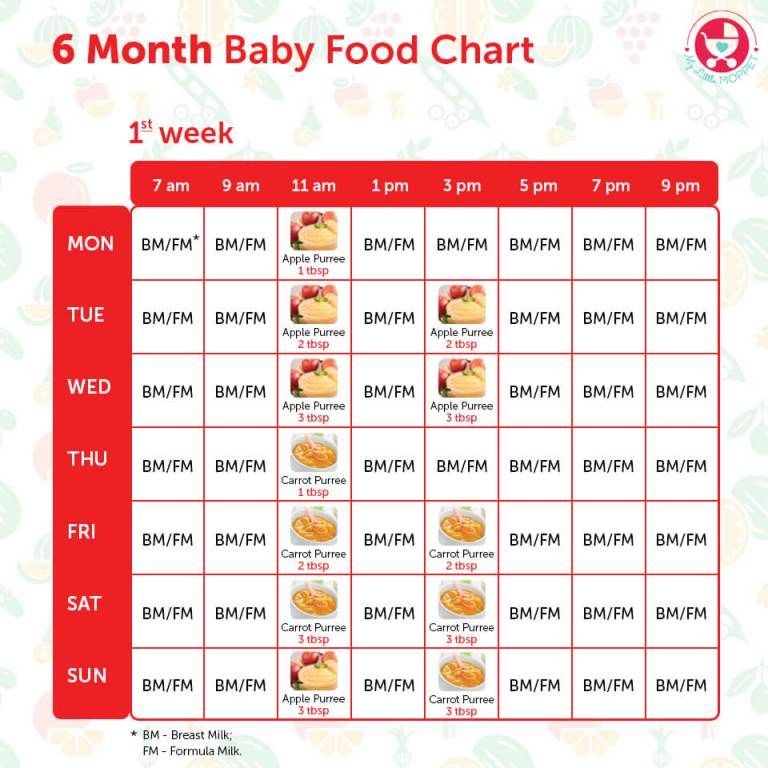
• If you prefer ready-made baby food, carefully study the top manufacturers, pay special attention to the shelf life when buying.
When introducing complementary foods, be guided by the data in the tables, which indicate which products, in what quantity and in what months experts recommend giving. 6 months
7 months
8 months
9 months
10 months
11 months
12 months
Vegetables
150 g
170 g
180 g
180 g
200 g
200 g
Porridge
180 g
180 g
180 g
200 g
200 g
FAITS
9000 9000 9000195
60 g
70 g
80 g
100 g
100 g
meat
50 g
60 g
70 g
70 g
70 g
Cottage cheese
9000 9000 9000 9000
195
10-30 g
30 g
40 g
50 g
50 g
ZELOK
9000 9000195
1/4
1/4
1/2
190
1/2
Fish
190
30 g
50 g
60 g
Vegetable oil
1 ml
3-5 ml
5 ml
5 ml
5 ml
oil
1 ml
3-5 ml
5 ml
5 ml
7 months
8 months
9 months
10 months
11 months
12 months
Silent porridge
10–150 g
150–180 g
3
200 g
200 g
200 g
Vegetables
10–120 g 9000 g 9000 9000
80–120 g
150 g
170 g
180 g
200 g
1 Military porridge
-
-
-
-
-
- 9000 - 9000 -
003
160–200 ml
Fruits
5–60 g
004 80–100 g
100–120 g
100–120 g
100–120 g
meat
190
-
10-30 g
30–70 g
60–70 g
60–70 g
Cottage cheese
-
-
5–10 g
10-30 g
40 g
50 g
Yolk
-
-
190
½
½
½
½ --1
Fish
-
-
-
10–40 g
10–40 g
Vegetable oil
-
-
1 ml
3-5 ml
5 ml
5 ml
Cream oil
-
-
195
3-4 g
5 g
5 g
5 g
, as you can see, the schemes for the introduction of feeding during infants are not too much. In any case, starting to introduce new foods into the baby's diet, you will have to give the baby milk or formula for a long time, which are still the basis of his nutrition.
In any case, starting to introduce new foods into the baby's diet, you will have to give the baby milk or formula for a long time, which are still the basis of his nutrition.
How to introduce solid foods by month
3 months
If your doctor advises your breastfeeding or formula-fed baby to introduce complementary foods at 3 months, start with what your specialist has recommended. If these are vegetables, start with the classic - zucchini puree. This vegetable contains many beneficial nutrients and fiber. Start with half a teaspoon, carefully observing the reaction of the child's body. Be sure to supplement your baby with breast milk or formula afterwards. In case the child does not like the zucchini, try giving broccoli or cauliflower. Well, if the doctor advised porridge, feel free to choose buckwheat or corn.
4-5 months
After your baby has tasted zucchini, broccoli and cauliflower, it's time to add other vegetables: carrots, potatoes, green peas. Do not overdo it with carrots, give it no more than 2 times a week. It is even better if this root crop is combined with other vegetables. It's porridge time! Gluten-free, water-cooked buckwheat, rice or corn. If the baby refuses to eat such cereals, add some breast milk or the usual mixture to them.
Do not overdo it with carrots, give it no more than 2 times a week. It is even better if this root crop is combined with other vegetables. It's porridge time! Gluten-free, water-cooked buckwheat, rice or corn. If the baby refuses to eat such cereals, add some breast milk or the usual mixture to them.
6 months
It's time to pamper your baby with dried fruit compote, and start giving milk porridges to formula-fed children. You can use a milk mixture to prepare such cereals, and in some cases, milk diluted with water. But in general, pediatricians do not advise introducing cow's milk into a child's diet before 8 months, as this can cause allergic reactions.
7 months
After the baby gets used to vegetable purees, you can try to give fruit purees and, if desired, juices, which should be diluted with water. There has been a lot of negative talk about juice lately. There is no fiber in them, but there are a lot of acids, which may not be completely safe for the stomach and have a high sugar content. So consult a pediatrician and think carefully about whether to give the baby juices or still prefer mashed potatoes and compotes. An excellent alternative to juices is children's herbal teas. Start introducing your baby to fruits with apples (preferably green varieties), bananas, and pears. The baby's menu is replenished with a new product - meat. Rabbit meat, turkey meat are best suited. Chicken and veal are also considered a good option. Low-fat pulp without streaks is taken. It is boiled or brought to readiness for a couple, then crushed in a blender or meat grinder. Meat with a gradual increase in its quantity is given as part of vegetable purees. Also at 7 months, it's time to give the baby a pumpkin.
So consult a pediatrician and think carefully about whether to give the baby juices or still prefer mashed potatoes and compotes. An excellent alternative to juices is children's herbal teas. Start introducing your baby to fruits with apples (preferably green varieties), bananas, and pears. The baby's menu is replenished with a new product - meat. Rabbit meat, turkey meat are best suited. Chicken and veal are also considered a good option. Low-fat pulp without streaks is taken. It is boiled or brought to readiness for a couple, then crushed in a blender or meat grinder. Meat with a gradual increase in its quantity is given as part of vegetable purees. Also at 7 months, it's time to give the baby a pumpkin.
8 months
An important moment in the introduction of complementary foods during artificial and breastfeeding occurs exactly at 8 months. It's time to give the baby a yolk. Watch the reaction of the body very carefully: if there are any manifestations of allergies.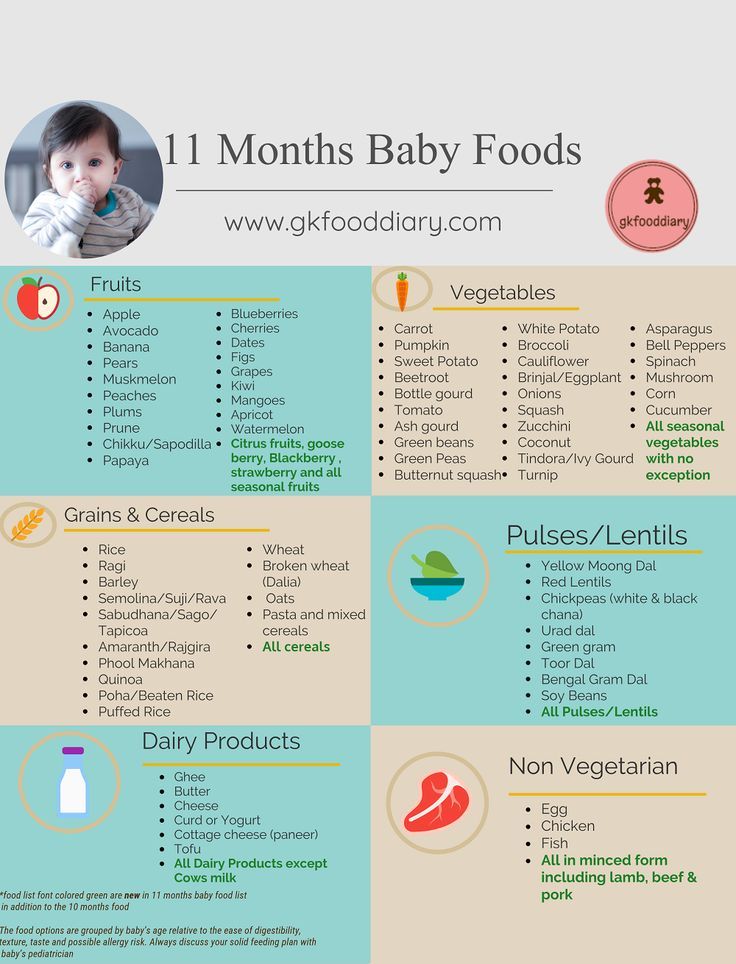 In case of a negative reaction of the body to chicken yolk, exclude it from the menu and try quail. It is best to give this product in the morning feeding from 9 to 11 hours. Along with vegetable and butter, gluten cereals are also introduced: oatmeal, millet, barley, pearl barley. It's time to give your child a taste of light vegetable soups. The components of the dish should be familiar to the child. Do not experiment by introducing dishes into the diet even with one unknown ingredient. Meatballs, boiled or steamed, are added to the meat in the form of mashed potatoes.
In case of a negative reaction of the body to chicken yolk, exclude it from the menu and try quail. It is best to give this product in the morning feeding from 9 to 11 hours. Along with vegetable and butter, gluten cereals are also introduced: oatmeal, millet, barley, pearl barley. It's time to give your child a taste of light vegetable soups. The components of the dish should be familiar to the child. Do not experiment by introducing dishes into the diet even with one unknown ingredient. Meatballs, boiled or steamed, are added to the meat in the form of mashed potatoes.
9 months
At this age, the baby should be introduced to the diet of low-fat fish: pollock, hake, perch, cod. For these purposes, fillets are taken and steamed, stewed or boiled. For the first time, fish are given in very small quantities. Start with once a week, gradually increasing to two. Remember that either fish or meat is given on the same day, without mixing these 2 products. If at the age of 8 months there were no prunes on the menu of the child, it's time to fix it.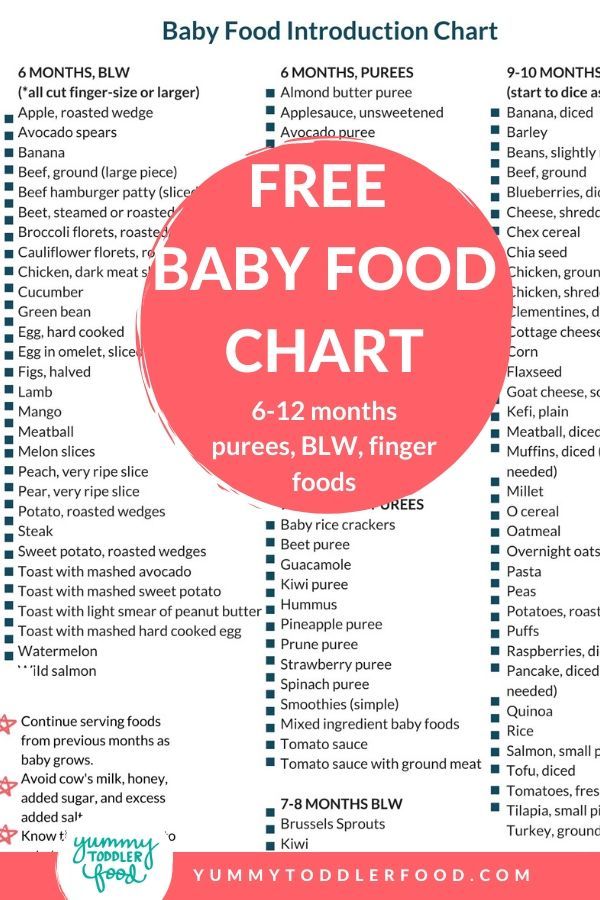 An excellent option is dried fruit compote, which at first is best diluted with water. However, you definitely shouldn’t get carried away with dried apricots, it’s better to wait until the baby reaches the age of one.
An excellent option is dried fruit compote, which at first is best diluted with water. However, you definitely shouldn’t get carried away with dried apricots, it’s better to wait until the baby reaches the age of one.
Months 10–12
The diet typical for this period is characterized by an increase in portions up to their maximum values indicated in the scheme. Also, it is at this age that the last feeding is gradually replaced by milk or kefir.
Now that you've come across a set of essential recommendations, you're ready to start weaning. Once again, consult with a specialist, be patient, not forgetting to listen to the baby's body. We are confident that you will succeed. The main thing here, as in any other business, is a positive attitude. It all depends on you and your desire to raise a healthy and happy baby with competent eating behavior. Don't stop if you fail and don't get frustrated if things don't go according to plan. Everything will definitely work out.